Abstract
The incision of DNA at apurinic/apyrimidinic sites (AP-sites) by chloro-6-methoxy-2 [(adenyl-9)-11)-4,8 diazadecyl]amino-9 acridine (Ade-Z-Acr), a 9-aminoacridine linked to an adenine, at nanomolar concentrations is described. Moreover, this drug, Ade-Z-Acr, is one of the most efficient drugs which cleaves DNA at AP-sites. The high activity is the result of the composition of the drug, since the individual components have no incising activity in the concentration range studied. The termini left by the Ade-Z-Acr molecule are a 3'deoxyribose and a 5'nucleotide. The termini and the inability of the Ade-Z-Acr to incise DNA with reduced AP-sites suggest that the mechanism of cleavage is beta-elimination.
Full text
PDF

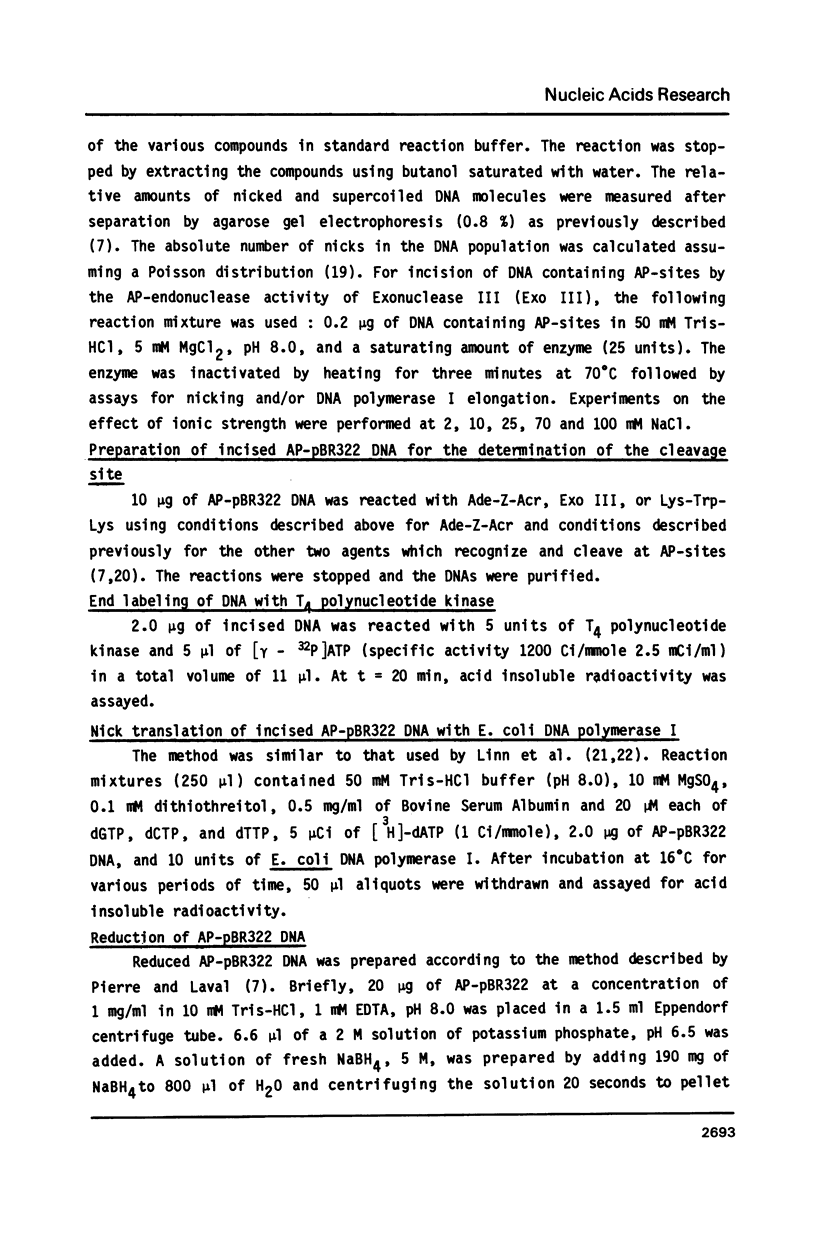


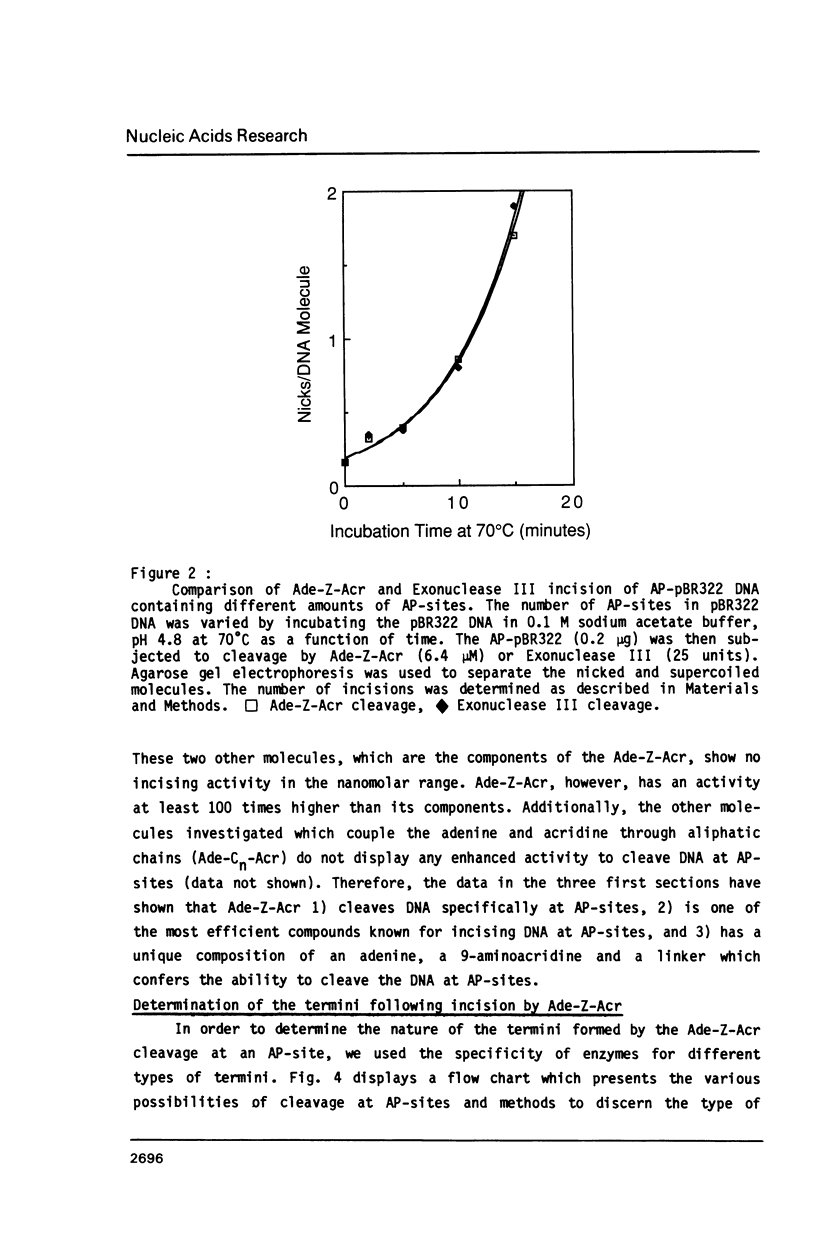
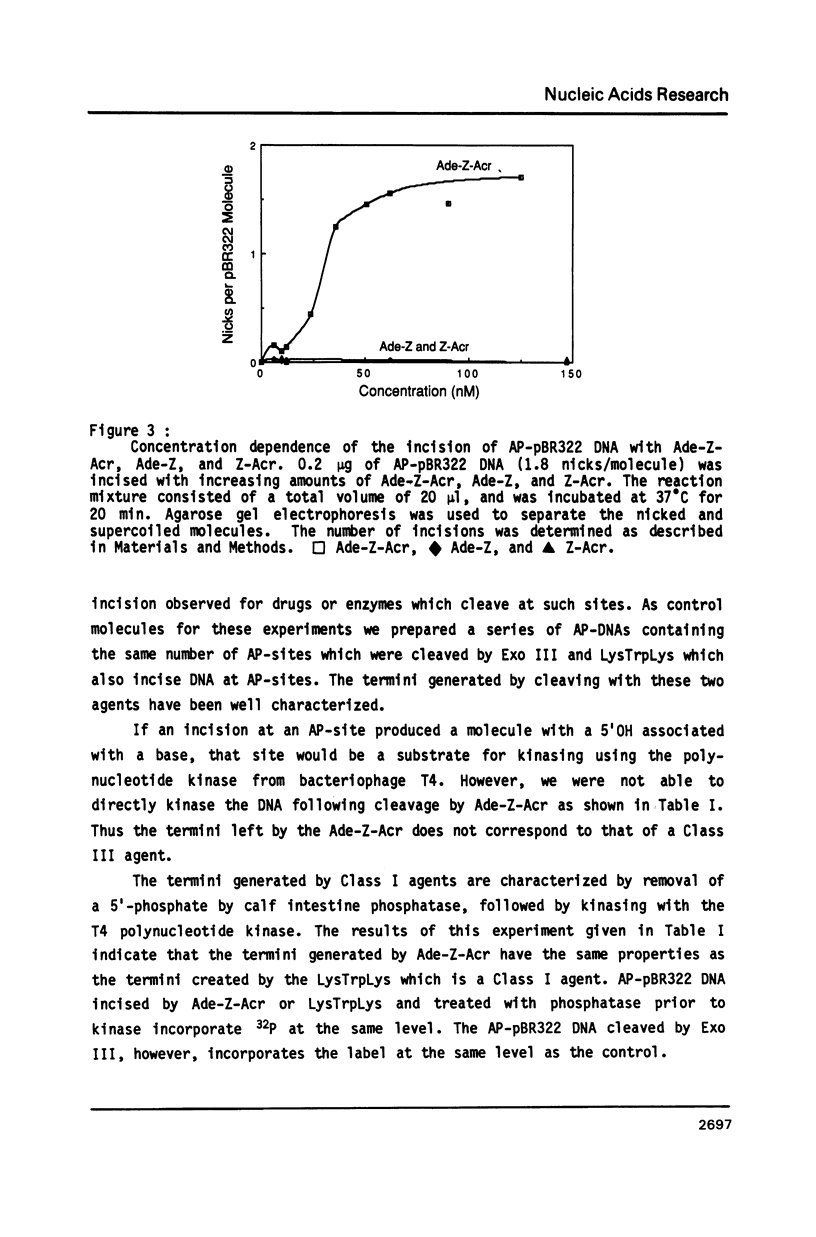

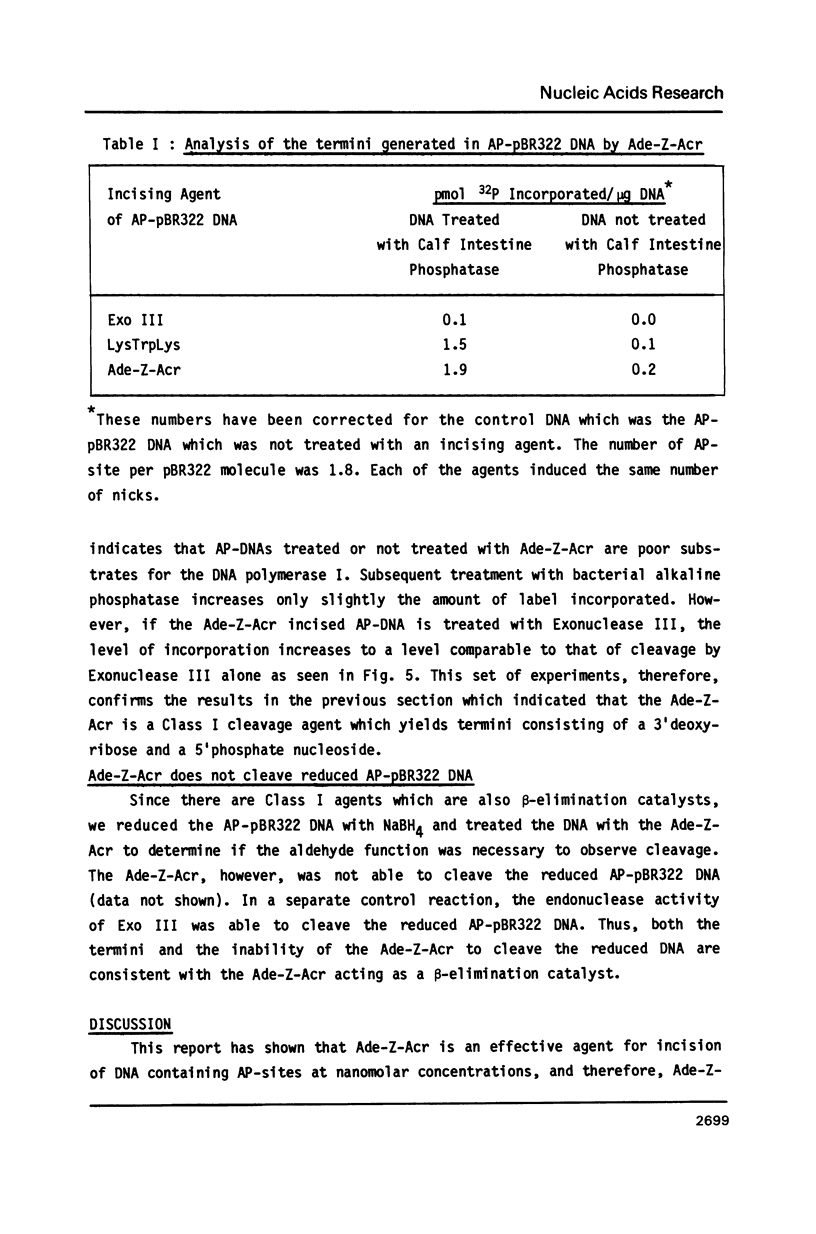


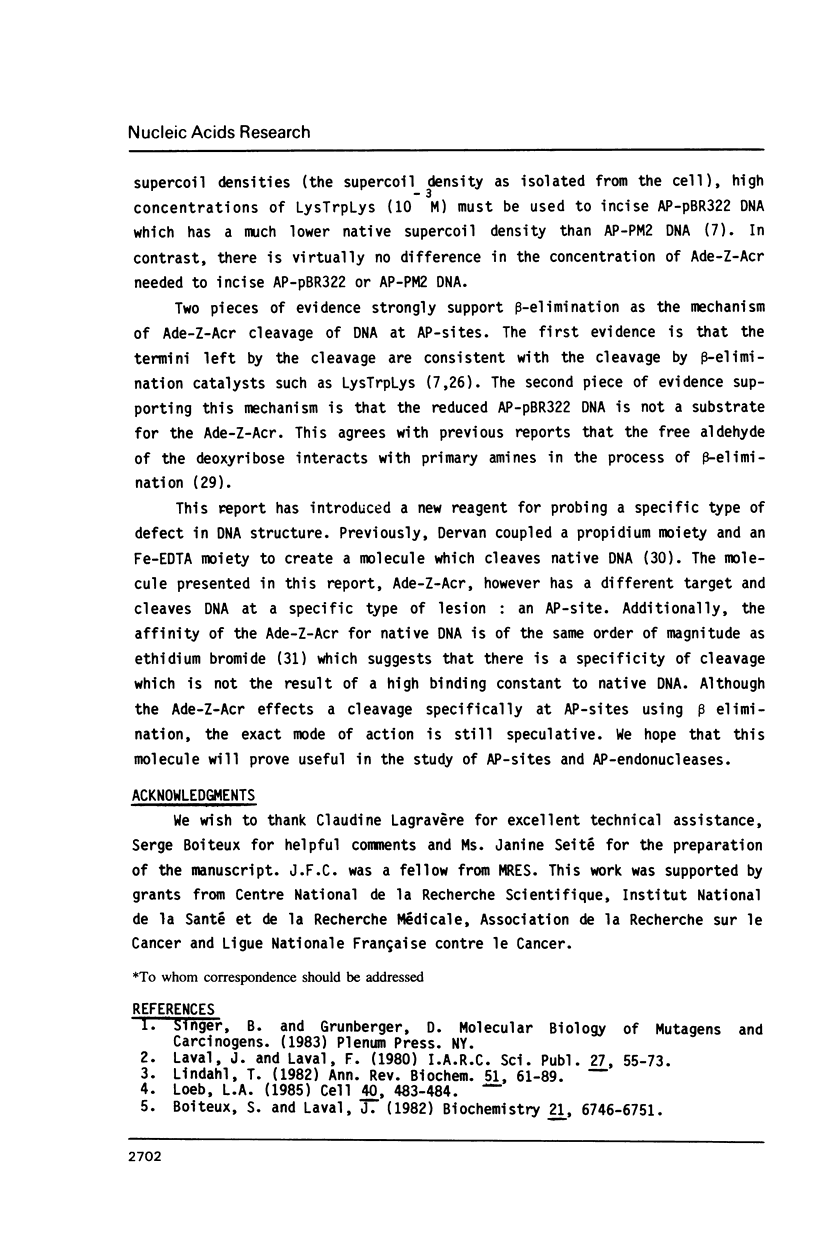
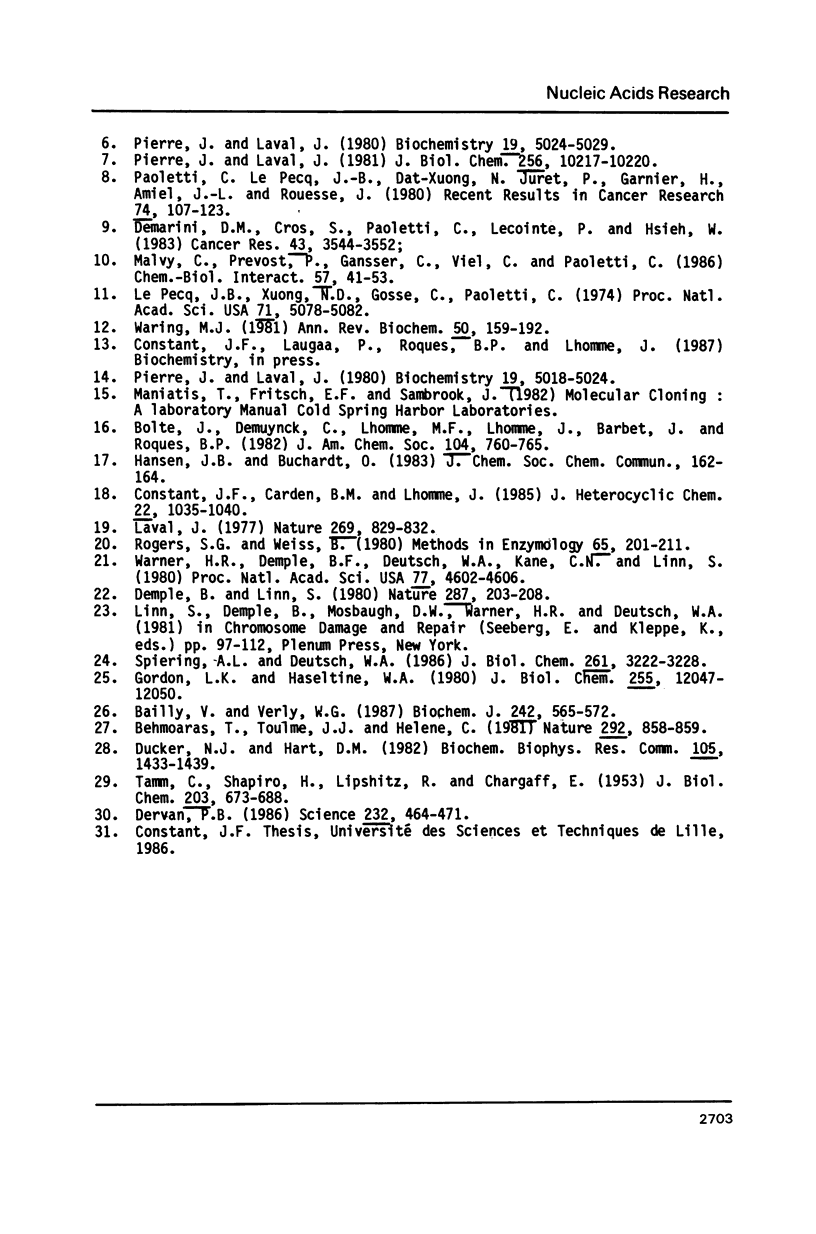
Selected References
These references are in PubMed. This may not be the complete list of references from this article.
- Bailly V., Verly W. G. Escherichia coli endonuclease III is not an endonuclease but a beta-elimination catalyst. Biochem J. 1987 Mar 1;242(2):565–572. doi: 10.1042/bj2420565. [DOI] [PMC free article] [PubMed] [Google Scholar]
- Boiteux S., Laval J. Coding properties of poly(deoxycytidylic acid) templates containing uracil or apyrimidinic sites: in vitro modulation of mutagenesis by deoxyribonucleic acid repair enzymes. Biochemistry. 1982 Dec 21;21(26):6746–6751. doi: 10.1021/bi00269a020. [DOI] [PubMed] [Google Scholar]
- DeMarini D. M., Cros S., Paoletti C., Lecointe P., Hsie A. W. Mutagenicity and cytotoxicity of five antitumor ellipticines in mammalian cells and their structure-activity relationships in Salmonella. Cancer Res. 1983 Aug;43(8):3544–3552. [PubMed] [Google Scholar]
- Demple B., Linn S. DNA N-glycosylases and UV repair. Nature. 1980 Sep 18;287(5779):203–208. doi: 10.1038/287203a0. [DOI] [PubMed] [Google Scholar]
- Dervan P. B. Design of sequence-specific DNA-binding molecules. Science. 1986 Apr 25;232(4749):464–471. doi: 10.1126/science.2421408. [DOI] [PubMed] [Google Scholar]
- Duker N. J., Hart D. M. Cleavage of DNA at apyrimidinic sites by lysyl-tryptophyl-alpha-lysine. Biochem Biophys Res Commun. 1982 Apr 29;105(4):1433–1439. doi: 10.1016/0006-291x(82)90948-2. [DOI] [PubMed] [Google Scholar]
- Gordon L. K., Haseltine W. A. Comparison of the cleavage of pyrimidine dimers by the bacteriophage T4 and Micrococcus luteus UV-specific endonucleases. J Biol Chem. 1980 Dec 25;255(24):12047–12050. [PubMed] [Google Scholar]
- Laval J., Laval F. Enzymology of DNA repair. IARC Sci Publ. 1980;(27):55–73. [PubMed] [Google Scholar]
- Laval J. Two enzymes are required from strand incision in repair of alkylated DNA. Nature. 1977 Oct 27;269(5631):829–832. doi: 10.1038/269829a0. [DOI] [PubMed] [Google Scholar]
- Le Pecq J. B., Nguyen-Dat-Xuong, Gosse C., Paoletti C. A new antitumoral agent: 9-hydroxyellipticine. Possibility of a rational design of anticancerous drugs in the series of DNA intercalating drugs. Proc Natl Acad Sci U S A. 1974 Dec;71(12):5078–5082. doi: 10.1073/pnas.71.12.5078. [DOI] [PMC free article] [PubMed] [Google Scholar]
- Lindahl T. DNA repair enzymes. Annu Rev Biochem. 1982;51:61–87. doi: 10.1146/annurev.bi.51.070182.000425. [DOI] [PubMed] [Google Scholar]
- Loeb L. A. Apurinic sites as mutagenic intermediates. Cell. 1985 Mar;40(3):483–484. doi: 10.1016/0092-8674(85)90191-6. [DOI] [PubMed] [Google Scholar]
- Malvy C., Prévost P., Gansser C., Viel C., Paoletti C. Efficient breakage of DNA apurinic sites by the indoleamine related 9-amino-ellipticine. Chem Biol Interact. 1986 Jan;57(1):41–53. doi: 10.1016/0009-2797(86)90047-5. [DOI] [PubMed] [Google Scholar]
- Paoletti C., Le Pecq J. B., Dat-Xuong N., Juret P., Garnier H., Amiel J. L., Rouesse J. Antitumor activity, pharmacology, and toxicity of ellipticines, ellipticinium, and 9-hydroxy derivatives: preliminary clinical trials of 2-methyl-9-hydroxy ellipticinium (NSC 264-137). Recent Results Cancer Res. 1980;74:107–123. doi: 10.1007/978-3-642-81488-4_15. [DOI] [PubMed] [Google Scholar]
- Pierre J., Laval J. Micrococcus luteus endonucleases for apurinic/apyrimidinic sites in deoxyribonucleic acid. 1. Purification and general properties. Biochemistry. 1980 Oct 28;19(22):5018–5024. doi: 10.1021/bi00563a013. [DOI] [PubMed] [Google Scholar]
- Pierre J., Laval J. Micrococcus luteus endonucleases for apurinic/apyrimidinic sites in deoxyribonucleic acid. 2. Further studies on the substrate specificity and mechanism of action. Biochemistry. 1980 Oct 28;19(22):5024–5029. doi: 10.1021/bi00563a014. [DOI] [PubMed] [Google Scholar]
- Pierre J., Laval J. Specific nicking of DNA at apurinic sites by peptides containing aromatic residues. J Biol Chem. 1981 Oct 25;256(20):10217–10220. [PubMed] [Google Scholar]
- Rogers S. G., Weiss B. Exonuclease III of Escherichia coli K-12, an AP endonuclease. Methods Enzymol. 1980;65(1):201–211. doi: 10.1016/s0076-6879(80)65028-9. [DOI] [PubMed] [Google Scholar]
- Spiering A. L., Deutsch W. A. Drosophila apurinic/apyrimidinic DNA endonucleases. Characterization of mechanism of action and demonstration of a novel type of enzyme activity. J Biol Chem. 1986 Mar 5;261(7):3222–3228. [PubMed] [Google Scholar]
- TAMM C., SHAPIRO H. S., LIPSHITZ R., CHARGAFF E. Distribution density of nucleotides within a desoxyribonucleic acid chain. J Biol Chem. 1953 Aug;203(2):673–688. [PubMed] [Google Scholar]
- Waring M. J. DNA modification and cancer. Annu Rev Biochem. 1981;50:159–192. doi: 10.1146/annurev.bi.50.070181.001111. [DOI] [PubMed] [Google Scholar]
- Warner H. R., Demple B. F., Deutsch W. A., Kane C. M., Linn S. Apurinic/apyrimidinic endonucleases in repair of pyrimidine dimers and other lesions in DNA. Proc Natl Acad Sci U S A. 1980 Aug;77(8):4602–4606. doi: 10.1073/pnas.77.8.4602. [DOI] [PMC free article] [PubMed] [Google Scholar]


